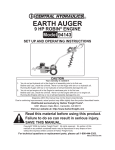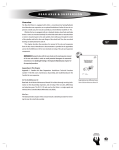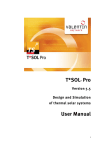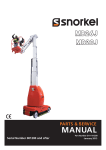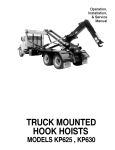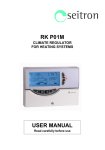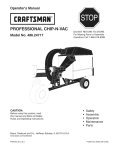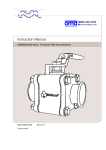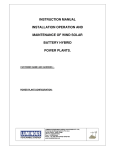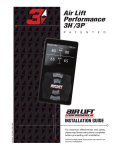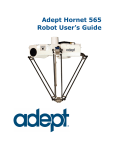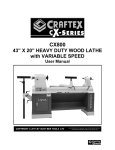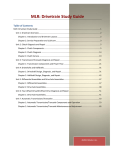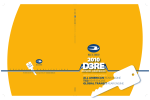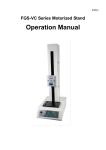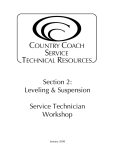Download ReaR axle & SuSpenSiOn - Central States Bus Sales, Inc.
Transcript
Rear Axle & Suspension Overview Rear Suspension This chapter includes routine maintenance and a procedure for removal of the axle and suspension from the bus chassis. Manufacturer’s documentation is provided in the appendixes and on the TechReference CD for more involved servicing of the axle and suspenion components. All Americans are equipped with one of three rear suspension systems: Hendrickson™ Softek.™ The Softek rear suspension is a 13-leaf (AAFE) or 14leaf(AARE) slipper spring configuration, and is standard equipment on both Front Engine and Rear Engine All American. Hendrickson™ Comfort Air.™ The Comfort Air rear suspension is a trailing arm configuration with 2 heavy duty rolling lobe air springs mounted rearward of axle and steel springs forward of the axle. The system features a quick align dog tracking adjustment. A transverse track rod controls lateral motion. Vertical motion is controlled by two 13/8” bore Sachs shock absorbers. A single height control valve maintains suspension height at varying loads. Ridewell™ Model 227. The Ridewell 227 rear suspension is a 4-bag air spring suspension incorporating a parallelogram linkage, and is optional on Rear Engine All American only. Vertical motion is controlled by adjustable heavy duty Koni shock absorbers. Two leveling valves permit leveling side to side and front to rear. Axle dog tracking is adjustable via eccentric torque arm bolts. 267 Single Reduction Rear Differential Carriers Meritor Publication Maintenance Manual 5A Forward Engine Rear Axle Meritor single reduction speed with synthetic bearing lubrication. Standard model is RS21-145; 21,000 lb GAWR; 5.29:1 reduction ratio. All American FE may be equipped with optional models depending upon GVWR and reduction ratio, suspension, and/ or brakes options: Meritor Model RS19-144 RS21-145 RC23-160 RS23-160 GAWR Details 19,000 lbs 21,000 lbs Standard. 23,000 lbs 23,000 lbs Rear Engine Rear Axle Meritor single reduction speed with synthetic lubed bearings. Standard model is RS23-160; 23,000 lbs. capacity; 5.38 to 1 ratio. All American RE may be equipped with optional models depending upon GVWR and reduction ratio, suspension, and/or brakes options: Meritor Model RS19-144 RS21-145 RC23-160 RS23-160 GAWR Details 19,000 lbs 21,000 lbs 23,000 lbs 23,000 lbs Standard. The specific axle model installed may be identified by refering to the axle data plate affixed to driveshaft side (front on Forward Engine, rear on Rear Engine) of the axle’s housing. RIDEWELL SUSPENSION 2 APPENDIX comfort air rear suspension 1 APPENDIX L service manual Whether the bus is equipped with air or hydraulic brakes, wheel hubs and brake drums or rotors are mounted similarly. The wheel hub (with either an attached drum or rotor) is mounted upon to the axle spindles. Axle shafts pass through the center of the spindles and bolt to the outer flange of the wheel hub. Thus, the rear wheel bearings are lubricated by the axle oil. Synthetic axle lubricant is standard. 268 [CAUTION] Towing the bus with the rear wheels on the road requires removal of the rear axle shafts in order to avoid potential damageto the automatic transmission. See Jacking & Towing in the Specs & Maintenance chapter for the required procedure. Appendixes In This Chapter [For Hendrickson Softek suspension service procedures, see Front Axle & Suspension chapter, Appendix 1.] Appendix 1. Comfort Air Rear Suspension. Hendrickson Technical Procedure number 17730-246 covers maintenance, disassembly, adn troubleshooting for the Comfort Air rear suspension. Appendix 2. Ridewell Air Rear Suspension. Ridewell publication covers maintenance, adjustment, and component replacement information on the Ridewell front and rear air suspension On The TechReference CD Rear Axle. Arvin Meritor Maintenance Manual 5A includes thorough servicing information on the disassembly, inspection, and servicing of the rear axles, differential, and reduction gears. The axles used on Blue Bird All Americans are single-speed axles without Driver Controlled Main Differential Lock (DCDL). Also See… The Hydraulc Brakes chapter of this manual includes a detailed procedure for removing the rear disc rotor/hub assembly. Maintenance Maintenance of the rear axle and suspension consists of periodic general inspection, checking tightness of fasteners, and axle lubrication fluid level check and/or replacement. Refer to the maintenance charts on the next page (also included in the Specs & Maintenance chapter) for intervals and lubricant specs. L rear axle & suspension Rear Axle & Suspension Interval: Months/1000 Miles Rear Axle Check lubricant Change Lubricant, Petroleum Based Change Lubricant Synthetic Spring Suspension Inspect visually Check rebound pins Torque spring radius fasteners Torque shock mounting bolts Torque U-bolt fasteners Air Suspension Inspect visually Torque upper shock mount Torque lower shock mount Check ride height Check U-bolts 7/8-14 UNF 28 Check U-bolts 3/4-16 UNF 28 Torque lower shock mount to spring Torque air spring anchor bolts Torque quick align bolts Torque lever linkage locknut Torque Leveling valve mount bolt 12 / 100,000 12 / 50,000 12 / 24,000 12 / 12,000 6 / 10,000 6 / 6,000 1 / 10,000 operation first 1000 miles whichever occurs first • • • • notes Hypoid Gear Oil. Capacity: 35 pints (16.9 litres). For viscosity recomendation, see Axle Lubricant chart, below. 269 • • • • • • • • • • • • • • • • • • • Verify that cotter pins are installed. TIghten locknuts to 100–125 ft·lb (11–14 Nm). Tighten locknuts to 75–100 ft·lb (9-11 Nm). Torque U-bolts to 300–350 ft·lb (34–39 Nm). Check for wear, damage; loose or missing parts. Tighten to 50–70 ft·lb (68–95 Nm) Tighten to 150–180 ft·lb (203–244 Nm) Shock length, eye to eye: 22.68” ± .25”. (576 ± 6 mm) Tighten to 400–450 ft·lb (542–610 Nm) Tighten to 260–320 ft·lb (353–434 Nm) Tighten to 260–320 ft·lb (353–434 Nm) Tighten to 20–30 ft·lb (27–41 Nm) Tighten to 525–575 ft·lb (712–800 Nm) Tighten to 100–150 in. lbs. (11–17 Nm) Tighten to 60–85 in. lbs. (7–10 Nm) Rear Axle Viscosity /Temperature Chart Meritor Lubricant Specification Description Cross Reference Minimum Outside Temperature Maximum Outside Temperature 0-76-A Hypoid Gear Oil GL-5, S.A.E. 85W/140 +10° F (-12.2° C) * 0-76-B Hypoid Gear Oil GL-5, S.A.E. 80W/140 -15° F (-26.1° C) * 0-76-D Hypoid Gear Oil GL-5, S.A.E. 80W/90 -15° F (-26.1° C) * 0-76-E Hypoid Gear Oil GL-5, S.A.E. 75W/90 -40° F (-40° C) * 0-76-J Hypoid Gear Oil GL-5, S.A.E. 75W -40° F (-40° C) +35° F (+1.6° C) 0-76-L Hypoid Gear Oil GL-5, S.A.E. 75W/140 -40° F (-40° C) * * No upper limit on these temperatures. However, axle sump temperature must never exceed + 250° F (121° C ). L service manual Rear Softek Suspension (Forward Engine Shown) 1 29.40 270 2 20 3.84 Forward Engine 2 1 3.34 Rear Engine 20.60 C/L 75-100 ft. lbs. REA RA XLE 10 15 13 (Forward Engine Shown) 12 75-100 ft. lbs. 9 9 (Forward Engine Shown) 11 16 15 26 100-125 ft. lbs. 25 8 7 5 24 25 4 0077616p 280-310 ft lbs. L rear axle & suspension Rear Softek Suspension Installation 1. Install spring hanger brackets (items 10 & 11) as shown. 2. Install pad assembly (item 13) using fasteners shown. The pad assembly should be installed so that the bracket makes contact with the bottom of the frame rail before tightening fasteners. 3. Place springs in the rear suspension installation jig with the radius leaf toward front of chassis. 271 4. Select proper axle per production order. 5 install saddle (item 5) over axle dowels at 40.00 spring centers. 6. Place axle housing on axle saddles (item 5) w/ axle centered on springs. To center axle housing,measure distance between outside edge of spring stack and inboard face of brake mtg. Flange (see detail a) for both left & right sides. Move axle side to side if required until difference of left & right measurement is .38 or less. Axle saddle (item 5) is to remain centered on spring (item 7.) 7. Square axle saddle with axle housing ± .06 at outer edge of pad. 8. Install u-bolt bracket (item 4) and spherical washers. 9. Install u-bolts (item 9) with u-bolt seat (item 8), between u-bolts and top of spring. Note u-bolt length variations by model. 10. Install shock on shock arm of bracket (item 4) as shown in diagram. 11. Use hardened flat washer and hi-nut on ends of u-bolts. Torque to 300-310 ft·lb. To prevent distortion of u-bolts, tighten nuts simutaneously w/4 spindle equipment or alternately in diagonal pattern w/manual equipment. 12. Install frame mounted shock brakets (items 1 & 2) as shown. 13. Install inner dual tire and wheel assemblies temporarily for movement of spring and axle assembly only. (if req’d) 14. Assemble spring and axle assembly to chassis. L service manual 15. When spring assembly makes contact with the rear spring hanger bracket (item 10), install rebound pin (item 15). Install cotter pin thru rebound pin as shown. (both sides of casting) when spring assembly makes contact w/ frt spring hanger brkt (item 11), install rebound pin (item 15). Install cotter pin thru cotter pin hole in casting and rebound pin as shown. 272 16. Attach spring radius leaf pin to front side of hanger (item 11), using fasteners as shown. Torque 5/8 fastener to 100-125 ft·lb. 17. Install shocks (item 12) as shown. If axle housing interferes with installing bolt, reverse bolt direction. Torque shock mounting 3/4 fasteners to 75-100 ft·lb. 18. If axle dog track adjustment is required, follow procedure below: 18.1 using beeline or other suitable equipment, make standard check for drive axle dog tracking. If laser mark is within 1/4” of center, no further alignment is required. Skip to step c). 18.2 if laser mark is greater than 1/4” from center, loosen fasteners (item 24) and add shims (item 16*) as req’d. Add only equal number of shims on each side of spring. Tighten fasteners and re-check alignment. Repeat step until laser mark is within 1/4” of center. 18.3 torque fasteners 100-125 ft-lbs. 19. See appropriate fuel tank & barrier installation diagram for part numbers and fasteners. 20. Due to initial relaxation and/or seating of suspension to axle connection hardware, retorquing of nuts on suspension u-bolts (items 9) prior to delivery is required. A minimum of two tightenings, one at initial assembly & one after body mount.It is preferable to do second one after road test, but anytime after body mount is acceptable. L rear axle & suspension 273 L service manual Rear Comfort Air Suspension, Forward Engine L 274 L K M K L K K L K K Centering Axle on Frame Measure from outside face of frame rail web to brake mounting flange, edge of brake drum, or edge of new tire. Measure both sides of chassis. Measurements should be equal within 1/4”. L 0040114ff M rear axle & suspension Torque Requirements key A B C D E F G H J K L M description torque U-bolt (High Locknut), 7/8”-14 Unf 2b 425 Ft.lbs. 3/4”-16 Unf 2b 290 Ft.lbs. Cross Channel To Main Support Mbr, 3/4”-10 Unc 2b 290 Ft.lbs. Air Spring To Cross Channel, 1/2”-13 Unc 2b 25 Ft.lbs. Quick Align Joint, Right Side Only, 1”- 8 Unc 2b 550 Ft.lbs. Quick Align Joint, Left Side Only, 1”- 8 Unc 2b 550 Ft.lbs. (100 Ft-lbs During Alignment) Shock Absorber, Upper Shock, 1/2”-13 Unc 2b 60 Ft.lbs. Shock Absorber, Lower Shock, 3/4”-10 Unc 2b 170 Ft.lbs. Linkage Rod Assy Locknut, 5/16”-24 Unf 2b 125 In.lbs. Leveling Valve Mounting, 1/4”-20 Unc 2b 72 In.lbs. Capscrew, 5/8”-11, Gr8 110 Ft.lbs. Air Spring Stud Nut, 3/4”-16 25 Ft.lbs. Hanger Assembly Nut, 3/4”-10 175 Ft.lbs. 275 L service manual Rear Comfort Air Suspension, Rear Engine 276 L K L M K M K L K K L K M M 0040115J Centering Axle on Frame Measure from outside face of frame rail web to brake mounting flange, edge of brake drum, or edge of new tire. Measure both sides of chassis. Measurements should be equal within 1/4”. L rear axle & suspension Torque Requirements key A B C D E F G H J K L M description torque U-bolt (High Locknut) 400-450 ft·lb Cross Channel To Main Support Mbr 260-320 ft·lb Air Spring To Cross Channel 20-30 ft·lb Quick Align Joint Right Side Only 525-575 ft·lb Quick Align Joint Left Side Only525-575 ft·lb /(100 ft·lb during alignment) Shock Absorber, Upper Shock 50-70 ft·lb Shock Absorber, Lower Shock 160-180 ft·lb Linkage Rod Assy Locknut 100-150 ft·lb Leveling Valve Mounting 60-85 ft·lb Capscrew, 5/8”-11, Gr8 90-122 Ft.lbs. Air Spring Stud Nut, 3/4”-16 25 Ft.lbs. Hanger Assembly Nut, 3/4”-10 155-210 Ft.lbs. 277 L service manual Rear Ridewell Suspension, Rear Engine G 278 B F B H F F D C D F F F F B G 17.53 + .25 F B A A F H E C Bottom of frame rail welds 8.00±.25 Top of mounting plate Anti-turn Washers 0042329h See Ride Height Adjustment L rear axle & suspension Torque Requirements key A B C D E F G H description Air Spring Stud Nut Air Spring Stud Nut U-Bolt Nuts Sway Bar L’Nut Hanger Beam L’Nut Hex Nut, 1/2”-13, Grd 8 Hex Nut, 5/8”-11, Grd 8 Suspension Hanger, Hex Nut, 3/4”-10, Grd 8 torque 25 ft·lb 50 ft·lb 350 ft·lb 460 ft·lb 1000 ft·lb 56 ft·lb 160-180 ft·lb 155-210 ft·lb 279 L service manual Ride height Ride height is defined as the distance between the axle and the bottom of the frame rail, and may be verified by measuring either shock length or air spring height: 280 Ridewell Ride Height (Frame to Axle): Shock length @ Ride Height Hendrickson: Ridewell: Air Spring Ride Height: 8.50” ±0.25” 22.68”±0.25” (eye to eye) 17.53” ±0.25” (eye to eye) 8.0±0.25” Ride Height Adjustment Air Suspension 1. Vehicle to be on level ground with 70-120 psi system air pressure maintained. Left and right rear height control valves to be adjusted independently. 2. Remove vertical rod from first valve horizontal arm & from lower stud. Rotate horizontal lever arm down to fully exhaust air springs. 3. Rotate horizontal lever up, filling air springs until affected side of vehicle is at specified ride height. Bring arm to neutral (horizontal) position when proper height is reached. 4. Place centering pins in valve to hold arm horizontal. Insert vertical link into upper connector, sliding up or down until lower grommet can be pushed onto lower mounting stud. Tighten hose clamp on upper connector and remove centering pins from valve. 5. Remove vertical link lower grommet from mounting stud and rotate horizontal link down to exhaust air. 6. Reinstall grommet on mounting stud and recheck ride height. 7. If adjustments are necessary, loosen hose clamp, slide connector up or down as required. Tighten clamp and repeat steps 5 & 6 until ride height measurement is within specifications. 8. Repeat steps 2-7 for 2nd valve. Drive Axle Alignment—Ridewell Air Suspension 1. Center axle in chassis, as follows: L 1.1 With chassis at normal ride height,measure from outside face of frame rail web to drive axle brake-mounting flange,edge of brake drum, or edge of tire (w/new tires only). Do for both sides. If measurements are within 1/8” skip to step 4. rear axle 1.2 Loosen track rod pinch bolts and with pipe wrench, rotate track rod shaft (item #18) to move frame laterally relative to axle. 1.3 Repeat steps 1) and 2) until axle has been centered within 1/8”. 1.4 Retighten pinch bolts to 150 ft-lbs. & suspension 2. Axle Dog-Track Alignment 2.1 Using beeline or other suitable equipment, make standard check for drive axle dog tracking. If laser mark is within 1/4” of center, no further drive axle alignment is required. Skip to step 3). 2.2 If laser mark is greater than 1/4” from center, loosen nuts (item #28), Rotate eccentric bolts (item #27) on appropriate side to center laser mark. Rotate both upper and lower eccentric bolts equally. Rotating eccentric bolts on both sides of chassis (in opposite directions) may be required to center laser mark. 2.3 Torque drive axle eccentric bolt nuts (item #28) to 1000 ft-lbs. 2.4 Add anti-turn washers (item #26) over head of eccentric bolt (item #27) and weld to receiver ring. 281 Adjusting of Koni Shocks 1. Remove the shock absorber from the vehicle. Place the lower eye attachment In a vise. Fully collapse shock absorber while turning dust cap to the left (counterclockwise) until it is felt that cams of internal adjusting nut engages in the recesses of the internal foot valve. While engaged, turning the dust cap fully counterclockwise puts the shock at its minimum dampening setting. Skip to step 3) if no damping increase is required. 2. Keeping shock absorber collapsed, turn dust cap to the right (clockwise) until a stop is felt. Stop turning and do not use any more force!! This Is the maximum dampening setting. To reduce dampening, turn counterclockwise. 3. Pull shock absorber out vertically without turning for at least 3/8” to disengage the adjusting mechanism. The dust cap may now be turned freely. Shock absorber can then be re-fitted to the vehicle. When reinstalling, tighten shock absorber upper & lower nut (item #23) until a dimensionof 1.75” between washers is attained, as shown. 4. Make certain both left and right shocks are at equal settings. Repeat steps 1–3 as required. L service manual Rear Spring & Axle Removal [WARNING] Never work under a bus supported solely by hydraulic jacks. Always use jack stands or blocks to secure the vehicle. Ensure that the floor is firm enough to support the weight of the vehicle on the reduced footprint of the lifting/holding device. 282 1. Raise the vehicle observing all appropriate safety precautions for working under the bus. 1.1 Park the bus on a level surface. 1.2 Apply the parking brakes. 1.3 Chock the wheels opposite those being lifted. 1.4 Using a jack or lift of sufficient strength, lift the bus to take the wheels off the floor. 1.5 Place jack stands of sufficient strength under the frame rails, forward of the front spring hanger brackets. 2. Remove rear wheels. 3. Disconnect the driveline at the differential by removing capscrews and ujoint straps. 4. Suspend the driveline safely out of the way. 5. Disconnect the wheel speed sensors. 6. If bus is equipped with hydraulic brakes, disconnect the hydraulic lines at the frame rails. 7. If bus is equipped with air brakes, release the air pressure from the air tanks. Then disconnect the air lines at the chassis frame rail. 8. Remove Shock Absorber as follows: L 8.1 Lift the axle/suspension assembly enough to take the weight off the suspension hangers. 8.2. Remove hexnut, flat washers, and bolt from the bottom end of the shock absorber. 8.3. Remove hexnut, flat washers and bolt from the top end of the shock absorber. The shock absorber can now be removed. rear axle & suspension [CAUTION] When reinstalling shock abosrbers, torque the bolts to 75 – 100 ft lb (102 – 135 Nm). Use the longer bolt at the bottom of the shock absorber. Install the top bolt with its head toward the front of the vehicle. Install the bottom bolt with its head toward the rear. 9. Remove the stabilizer bar, if so equipped, by removing locknut, flat washers and bolt from each end of the axle. 10. To drop the axle, remove hex nuts, flat washer and spherical washer from 4 places, and lower the axle/wheels assembly. 283 [CAUTION] If working on only one end of the axle, it is possible to do so by dropping only one side. However, care must be taken to avoid twisting the suspension on the other side. Lower the end being worked on only enough to clear the location pins on the springs and axle. This will make location of components easier during reassembly. 11. To drop the springs, skip step 12 and remove and discard the cotter pin from the rebound pin at the forward spring hanger. 12. Remove the rebound pin. 13. Remove and discard the cotter pin from the rebound pin at the rearward spring hanger. [CAUTION] Carefully note the position of any shims in the next step. During reassembly, they must be replaced in the same positions. 14. Remove hexnuts (26), flat washers (25), shims (16) and bolt (24) from 2 places at the rearmost spring hanger (11). 15. Loosely install the inner wheels onto axle ends. 16. Carefully lower the suspension/axle/wheels assembly and roll it out from under the vehicle. [WARNING] If any frame members are to be removed, or any suspension hangers, they must be replaced in accordance with instructions in the Frame section of this service manual. L service manual Rear Spring & Axle Installation Installation of the rear spring suspension is accomplished in the reverse order of the removal instructions above, and according to the torque values below: [WARNING] Always use new hardware when installing high torque, suspension applications. 284 • Torque hexnuts at the rear hanger to 100 – 125 ft lb (135 – 169 Nm). • Use new cotter pins at the rebound pins. Bend each leg of the cotter pin, at least, 45° to secure it. • Torque hexnuts (30) to 75 – 100 ft lb (102 – 135 Nm). • Torque hexnuts (32) to 300 – 350 ft lb (407 – 474 Nm). • Torque hexnuts (40) to 106 – 112 ft lb (144 – 151 Nm). • Install brake lines in accordance with instructions in the Brakes Section of this service manual. • Install speed sensors in accordance with instructions in the Brakes Section of this manual. • Install wheels in accordance with instructions in the Front Suspension Section of this service manual. [WARNING] Always use new hardware in high-torque applications. Never reuse hardware in suspension applications. 1. Position the axle saddle block over the location pin on the axle housing. 2. Position the spring assembly in the saddle block. 3. Position the U-bolt seat on the top of the spring. 4. Position a new U-bolt at the forward groove in the U-bolt seat. 5. Position a new U-bolt at the rearward groove of the U-bolt seat. 6. Position the lower U-bolt bracket over the ends of the U-bolts. 7. Install the spherical washers on the U-bolt. [CAUTION] Flat washers must be hardened. 8. Install the flat washers on the U-bolt. 9. Loosely install the hexnuts on U-bolt. 10. Install the spherical washers on U-bolt at 2 places. L rear axle & suspension 11. Install the stabilizer bar bracket, if so equipped, on U-bolt. 12. Install the lower shock absorber bracket on U-bolt. 13. Install flat washers on U-bolt. 14. Loosely (snugly enough to prevent movement) install hexnuts on U-bolt. [CAUTION] To prevent distortion of the U-bolts, tighten hexnuts in a crisscross pattern after initial contact (snug). 285 15. Temporarily install the inner wheels and position the axle assembly in the hanger brackets to ensure the springs are located properly. Then remove the wheels. 16. Position the rearward spring end in the rearward spring bracket. 17. Install the rebound pin in the aft mounting bracket. 18. Position the forward spring end in the forward mounting bracket. 19. Locate the spring radius leaf pin at the forward side of the bracket. 20. Install the rebound pin. 21. Install new bolts through the spring end assembly and the forward spring mounting bracket lugs. 22. Install new cotter pins. [CAUTION] Ensure that any shim(s) removed during disassembly are replaced in the proper positions. Ensure that the bolts are oriented in the proper direction. 23. Install shims (16) between the head of the bolts and the lugs on the mounting bracket. 24. Install new cotter pins at rebound pins, front and rear. 25. Install flat washers on bolts. 26. Install hexnuts. 27. Make standard check for dog tracking adjustment. L service manual 28. When laser mark is within 1/4-inch of center (adjusted with shims in step 23 above), torque hexnuts to 100 – 125 ft lb (135 – 169 Nm). 29. Using a crisscross pattern, torque hexnuts to 300 – 350 ft lb (407 – 474 Nm) in 10 ft lb (13 Nm) increments. 30. Install flat washer on bolt. 286 31. Position the top end of the shock absorber between the shock absorber brackets on the frame rails. Ensure that the bolt is properly oriented with the head toward the front of the bus. 32. Install bolt and washer through the hanger brackets and the top end of the shock absorber. 33. Install the flat washer on bolt. 34. Install hexnut on bolt. Torque to 75 – 100 ft lb (102 – 135 Nm). 35. Position the lower end of the shock absorber at the lower shock mount. Ensure the bolt is properly oriented with the head toward the rear of the bus. 36. Install a flat washer on bolt. 37. Install bolt and flat washer through the lower end of the shock and install a flat washer on the bolt. 38. Position the lower end of the shock at the lower shock mounting bracket and install the bolt and washer assembly through the lower mounting bracket. 39. Install a flat washer and hexnut on bolt. Torque to 75 – 100 ft lb (102 – 135 Nm). 40. Install brake lines in accordance with instructions in the Brakes Section of this service manual. 41. Install speed sensors in accordance with instructions in the Brakes Section of this service manual. 42. Install wheels in accordance with instructions in the Brakes Section of this service manual. Air Rear Suspension For servicing the Hendrickson Comfort Air™ rear suspension, see Appendix 1 of this chapter, Hendrickson publication number 17730-246. L rear axle & suspension 287 L service manual 288 L rear axle & suspension appendixes TECHNICAL PROCEDURE ® COMFORT AIR™ SUBJECT: Service Instructions LIT NO: 17730-246 DATE: December 2001 REVISION: A TABLE OF CONTENTS Section 1 Introduction . . . . . . . . . . . . . . . . . . . . . . . . . . . . . . . . . . . . . 2 Section 2 Product Description . . . . . . . . . . . . . . . . . . . . . . . . . . . . . . 2 Section 3 Important Safety Notice . . . . . . . . . . . . . . . . . . . . . . . . . . . 3 Section 4 Parts Lists . . . . . . . . . . . . . . . . . . . . . . . . . . . . . . . . . . . . . . 6 Section 5 289 Preventive Maintenance Main Support Member Bushings . . . . . . . . . . . . . . . . . . . . . . . . . . 8 U Bolt Locknuts . . . . . . . . . . . . . . . . . . . . . . . . . . . . . . . . . . . . . . 8 Ride Height Setting. . . . . . . . . . . . . . . . . . . . . . . . . . . . . . . . . . . . 8 Transverse Rods . . . . . . . . . . . . . . . . . . . . . . . . . . . . . . . . . . . . 10 Shock Absorber . . . . . . . . . . . . . . . . . . . . . . . . . . . . . . . . . . . . . 10 Section 6 Section 7 Alignment . . . . . . . . . . . . . . . . . . . . . . . . . . . . . . . . . . . . . . 12 Component Replacement Frame Hanger . . . . . . . . . . . . . . . . . . . . . . . . . . . . . . . . . . . . . . 14 Main Support Member Assembly . . . . . . . . . . . . . . . . . . . . . . . . . 15 Main Support Member Assembly Pivot Bushing . . . . . . . . . . . . . . . 17 Spring Seat/Bottom Cap . . . . . . . . . . . . . . . . . . . . . . . . . . . . . . . 19 Air Spring . . . . . . . . . . . . . . . . . . . . . . . . . . . . . . . . . . . . . . . . . 21 Cross Channel. . . . . . . . . . . . . . . . . . . . . . . . . . . . . . . . . . . . . . 22 Shock Absorber . . . . . . . . . . . . . . . . . . . . . . . . . . . . . . . . . . . . . 23 Upper Shock Absorber Frame Bracket . . . . . . . . . . . . . . . . . . . . . . 23 Lower Shock Absorber Bracket. . . . . . . . . . . . . . . . . . . . . . . . . . . 24 Ride Height Control Valve . . . . . . . . . . . . . . . . . . . . . . . . . . . . . . 25 Transverse Rod . . . . . . . . . . . . . . . . . . . . . . . . . . . . . . . . . . . . . 26 Transverse Rod Bushing . . . . . . . . . . . . . . . . . . . . . . . . . . . . . . 26 Section 8 COMFORT AIR Plumbing Diagram . . . . . . . . . . . . . . . . . . 28 Section 9 Trouble Shooting Guide . . . . . . . . . . . . . . . . . . . . . . . . . . . 29 Section 10 Tightening Torque Specifications . . . . . . . . . . . . . . . . . . . 30 1 APPENDIX L service manual COMFORT AIR™ SECTION 1 Introduction This publication is to acquaint and assist maintenance personnel in preventive maintenance and rebuild of the COMFORT AIRTM suspension system. 290 NOTE Use only Genuine Hendrickson parts for servicing this suspension system. Most Hendrickson parts can be identified by the Hendrickson trademark. It is important to read and understand the entire Technical Procedure publication prior to performing any maintenance, service, repair, or rebuild of the product. The information in this publication contains parts lists, safety information, product specifications, features, proper maintenance and rebuild instructions for the COMFORT AIR Suspension. Hendrickson reserves the right to make changes and improvements to its products and publications at any time. Contact Hendrickson Tech Services at 630-910-2800 for information on the latest version of this manual. SECTION 2 Product Description The COMFORT AIR rear suspension system, based on Hendrickson's proven HAS technology, is designed for the needs of buses, motor homes, and ambulances. The new system combines superior ride and handling with enhanced equipment protection. ■ Frame Hanger Bracket — Wide footprint distributes load over a larger area for reduced frame stress. ■ QUIK-ALIGN® — Fast and easy alignment without shims, see Figure2-1. ■ Main Support Member — Extended-length generates lower spring rate for optimized roll stiffness providing a more comfortable and compliant ride. It also provides neutral roll steer for better handling ■ Shock Absorbers — Shock absorbers are tuned for optimum damping characteristics to provide maximum driving comfort. ■ Air Springs — Adjusts to changing load conditions to deliver superior ride quality. ■ ULTRA ROD® — Lightweight and durable torque rod, the ULTRA ROD is an integral component of the COMFORT AIR suspension that enhances handling during cornering and helps maintain lateral axle position. ■ Height Control Valve — Maintains precise ride height control through changing road surfaces, load, and driving conditions. 2 L 1 APPENDIX 17730-246 rear axle & suspension appendixes COMFORT AIR™ COMFORT AIR is available in suspension capacities up to 23,000 pounds, and in ride heights of 8.5" and 10.5". The suspension weighs 487 pounds and includes the frame hanger brackets, main support member assembly, axle clamp group, air springs, shock absorbers, cross channel, upper and lower shock brackets, ULTRA ROD transverse torque rod and frame bracket, and height control system. Figure 2-1 291 SECTION 3 IMPORTANT SAFETY NOTICE Proper maintenance service and repair is important to the reliable operation of the suspension. The procedures recommended by Hendrickson and described in this technical publication are methods of performing such maintenance, service and repair. The warnings and cautions should be read carefully to help prevent personal injury and to assure that proper methods are used. Improper servicing may damage the vehicle, cause personal injury, render it unsafe in operation, or void manufacturer's warranty. Failure to follow the safety precautions in this manual can result in personal injury and/or property damage. Carefully read and understand all safety related information within this publication, on all decals and that provided by the vehicle manufacturer before conducting any maintenance, service or repair. EXPLANATION OF SIGNAL WORDS Hazard “Signal Words” (Danger-Warning-Caution) appear in various locations throughout this publication. Information accented by one of these signal words must be observed to help minimize the risk of personal injury to service personnel, or possibility of improper service methods which may damage the vehicle or render it unsafe. Additional Notes or Service Hints are utilized to emphasize areas of procedural importance and provide suggestions for ease of repair. The following definitions indicate the use of these signal words as they appear throughout the publication. 17730-246 3 1 APPENDIX L service manual COMFORT AIR™ INDICATES IMMEDIATE HAZARDS WHICH WILL RESULT IN SEVERE PERSONAL INJURY OR DEATH. INDICATES HAZARDS OR UNSAFE PRACTICES WHICH COULD RESULT IN SEVERE PERSONAL INJURY OR DEATH. 292 INDICATES HAZARDS OR UNSAFE PRACTICES WHICH COULD RESULT IN DAMAGE TO MACHINE OR MINOR PERSONAL INJURY. NOTE An operating procedure, practice condition, etc. which is essential to emphasize. SERVICE HINT A helpful suggestion which will make the servicing being performed a little easier and/or faster. WARNINGS FASTENERS LOOSE OR OVER TORQUED FASTENERS CAN CAUSE COMPONENT DAMAGE, LOSS OF VEHICLE CONTROL, PROPERTY DAMAGE, OR SEVERE PERSONAL INJURY. MAINTAIN CORRECT TORQUE VALUE AT ALL TIMES. CHECK TORQUE VALUES ON A REGULAR BASIS AS SPECIFIED. LOAD CAPACITY ADHERE TO THE PUBLISHED CAPACITY RATINGS FOR THE SUSPENSION. ADD ON AXLE ATTACHMENTS AND OTHER LOAD TRANSFERRING DEVICES CAN INCREASE THE SUSPENSION LOAD ABOVE ITS RATED AND APPROVED CAPACITIES, WHICH CAN RESULT IN COMPONENT DAMAGE AND LOSS OF VEHICLE CONTROL, POSSIBLY CAUSING PERSONAL INJURY OR PROPERTY DAMAGE. MODIFYING COMPONENTS DO NOT MODIFY OR REWORK PARTS. DO NOT SUBSTITUTE PARTS OF THE SUSPENSION. USE OF MODIFIED OR REPLACEMENT PARTS NOT AUTHORIZED BY HENDRICKSON MAY NOT MEET HENDRICKSON'S SPECIFICATIONS, AND CAN RESULT IN COMPONENT DAMAGE, LOSS OF VEHICLE CONTROL, AND POSSIBLE PERSONAL INJURY OR PROPERTY DAMAGE. USE ONLY HENDRICKSON AUTHORIZED REPLACEMENT PARTS. DO NOT MODIFY PARTS WITHOUT AUTHORIZATION FROM HENDRICKSON. TORCH/WELDING DO NOT USE A CUTTING TORCH TO REMOVE ANY ATTACHING FASTENERS. THE USE OF HEAT ON SUSPENSION COMPONENTS WILL ADVERSELY AFFECT THE STRENGTH OF THESE PARTS. EXERCISE EXTREME CARE WHEN HANDLING OR PERFORMING MAINTENANCE IN THE AREA OF THE MAIN SUPPORT MEMBER. DO NOT CONNECT ARC WELDING GROUND LINE TO THE MAIN SUPPORT MEMBER. DO NOT STRIKE AN ARC WITH THE ELECTRODE ON THE MAIN SUPPORT MEMBER ASSEMBLY AND AXLE. DO NOT USE HEAT NEAR THE MAIN SUPPORT MEMBER ASSEMBLY. DO NOT NICK OR GOUGE THE MAIN SUPPORT MEMBER ASSEMBLY. SUCH IMPROPER ACTIONS CAN CAUSE DAMAGE TO THE MAIN SUPPORT MEMBER ASSEMBLY COULD FAIL, AND CAUSE LOSS OF VEHICLE CONTROL AND POSSIBLE PERSONAL INJURY OR PROPERTY DAMAGE. 4 L 1 APPENDIX 17730-246 rear axle & suspension appendixes COMFORT AIR™ PROCEDURES AND TOOLS A TECHNICIAN USING A SERVICE PROCEDURE OR TOOL WHICH HAS NOT BEEN RECOMMENDED BY HENDRICKSON MUST FIRST SATISFY HIMSELF THAT NEITHER HIS SAFETY NOR THE VEHICLE'S SAFETY WILL BE JEOPARDIZED BY THE METHOD OR TOOL SELECTED. INDIVIDUALS DEVIATING IN ANY MANNER FROM THE INSTRUCTIONS PROVIDED WILL ASSUME ALL RISKS OF CONSEQUENTIAL PERSONAL INJURY OR DAMAGE TO EQUIPMENT INVOLVED. SHOCK ABSORBERS 293 THE SHOCK ABSORBERS ARE THE REBOUND TRAVEL STOPS FOR THE SUSPENSION. ANYTIME THE AXLE ON A COMFORT AIR SUSPENSION IS SUSPENDED IT IS MANDATORY THAT THE SHOCK ABSORBERS REMAIN CONNECTED. FAILURE TO DO SO CAN CAUSE THE AIR SPRINGS TO SEPARATE FROM THE PISTON AND RESULT IN PREMATURE AIR SPRING FAILURE. PERSONAL PROTECTIVE EQUIPMENT ALWAYS WEAR PROPER EYE PROTECTION AND OTHER REQUIRED PERSONAL PROTECTIVE EQUIPMENT TO HELP PREVENT PERSONAL INJURY WHEN PERFORMING VEHICLE MAINTENANCE, REPAIR OR SERVICE. PARTS CLEANING SOLVENT CLEANERS CAN BE FLAMMABLE, POISONOUS, AND CAUSE BURNS. TO HELP AVOID SERIOUS PERSONAL INJURY, CAREFULLY FOLLOW THE MANUFACTURER’S PRODUCT INSTRUCTIONS AND GUIDELINES AND THE FOLLOWING PROCEDURES: 1. WEAR PROPER EYE PROTECTION. 2. WEAR CLOTHING THAT PROTECTS YOUR SKIN. 3. WORK IN A WELL-VENTILATED AREA. 4. DO NOT USE GASOLINE, OR SOLVENTS THAT CONTAIN GASOLINE. GASOLINE CAN EXPLODE. 5. HOT SOLUTION TANKS OR ALKALINE SOLUTIONS MUST BE USED CORRECTLY. FOLLOW THE MANUFACTURER'S RECOMMENDED INSTRUCTIONS AND GUIDELINES CAREFULLY TO HELP PREVENT PERSONAL ACCIDENT OR INJURY. DO NOT USE HOT SOLUTION TANKS OR WATER AND ALKALINE SOLUTIONS TO CLEAN GROUND OR POLISHED PARTS. DOING SO WILL CAUSE DAMAGE TO THE PARTS AND VOID WARRANTY. QUIK-ALIGN FASTENERS DO NOT ASSEMBLE QUIK-ALIGN JOINT WITHOUT PROPER FASTENERS. USE ONLY DACROMET PLUS XL PLATED FASTENERS TO SUSTAIN PROPER CLAMP FORCE. FAILURE TO DO SO CAN CAUSE LOSS OF VEHICLE CONTROL, PROPERTY DAMAGE OR PERSONAL INJURY. ENSURE THAT QUIK-ALIGN FASTENERS TORQUE VALUE IS SUSTAINED AS RECOMMENDED IN THE TORQUE REQUIREMENTS SECTION OF THIS PUBLICATION. FAILURE TO SO CAN CAUSE LOSS OF VEHICLE CONTROL RESULTING IN PERSONAL INJURY OR PROPERTY DAMAGE. 17730-246 5 1 APPENDIX L service manual SECTION 4 Parts Lists 294 6 L 1 APPENDIX 17730-246 rear axle & suspension appendixes COMFORT AIR™ KEY NO. PART NO. 1 2 60784-000 60632-001 34013-103 3 4 5 6 7 64107-000 64097-000 64096-000 22962-035 64108-000 60925-002 60929-002 8 9 10 11 -57096-002 22962-014 17700-010 60779-000 -58648-000 37674-051 64817-000 49175-026 12 13 14 15 16 17 18 19 20 21 -64272-000 37042-002 22962-027 17700-007 -56805-000 57724-000 4871848718-104 22 4741749684-014 23 24 48574-000 22962-002 22962-001 25 50765-000 49685-000 26 27 48531-014 57022-010 56501-006 56501-019 56501-020 56501-021 56501-020 28 57024-000 50216-000 29 17730-246 50216-000 -- DESCRIPTION NO.REQ. KEY NO. PART NO. Frame Hanger 2 QUIK-ALIGN® Kit (Includes Key Nos. 3-7) 1 Pivot Bushing Service Kit (Includes Key Nos.3, 6, 7, 13, 15) Services 1 Side Only 1" 8UNC 7.50" Bolt 2 QUIK-ALIGN Concentric Collar 3 QUIK-ALIGN Eccentric Collar 1 1" Hardened Washer 4 1" 8UNC Locknut 2 Air Spring Assy. (Includes Key Nos. 9-11) 2 Air Spring Assy, Front Engine (Includes 2 Key Nos. 9-11) Air Spring 2 Air Spring Hanger 2 Washer 2 1/2"-13UNC Nylocknut 2 MSM Assy. (Includes Key Nos. 12-20) 2 Main Support Member 2 Pivot Bushing 2 Liner 4 Puck 4 Spring Clip Fastener Kit (Includes Key Nos.17, 18, Washer, 19) Secondary Leaf 4 Spring Clip Sleeve 4 7/16" 14UNC Bolt 2 7/16" Washer Not Shown 7/16" 14UNC Nut 2 Clip Bolt Spacer 2 Top Pad 2 Top Pad (15,000 lb. capacity) 2 U Bolt Kit 7/8" Specify Length,(Includes Key Nos. 22,23,24,25) 3/4" 15,000 lb. capacity, (Includes Key Nos. 22,24,25) 7/8" 14UNF U Bolt - Specify Length 4 3/4" 26UNF U Bolt - 12.5" (15,000 lb.Capacity) 4 Spherical Washer 8 7/8" Hardened Flat Washer 8 3/4" Hardened Flat Washer (15,000 lb. Capacity) 8 7/8" 14UNF U-Bolt Locknut 8 3/4" 16UNF U-Bolt Locknut (15,000 lb. Capacity) 8 Spacer 1.5" (As Required) 2 Spring Seat 2 Meritor RS15-120 4.5º Pinion Angle LH/RH Meritor RS21-145, RS23-160 4.5º Pinion Angle LH/RH 0.0º Pinion Angle LH/RH 4.5º Pinion Angle LH/RH 0.0º Pinion Angle LH/RH Meritor RC23-160 Negative 4.5º Pinion Angle LH/RH Axle Bottom Cap 2 Meritor RS15-120 2-5.0º Pinion Angle LH/RH Meritor RS21-145, RS23-160 0-9.5º Pinion Angle LH/RH Meritor RC23-160 Negative 0-9.5º Angle LH/RH Cross Channel 1 (Contact Tech Services for proper Cross Channel) 57356-000 30 31 32 33 -50764-002 22962-001 49842-000 50763-004 34 35 36 37 38 50764-003 50764-005 22962-001 49842-000 49177-006 39 40 41 42 22962-014 17700-010 60998-001 57322-002 43 44 45 46 47 -50368-000 22962-031 49846-000 59013-000 48 49 50 -22962-028 49983-000 51 52 53 54 55 56 57 58 59 60 61 62 63 64 57430-000 57430-003 56789-000 58367-000 56935-002 22962-028 49983-000 58994-------6200049689-000 22186-000 DESCRIPTION NO.REQ. Lower Shock Bracket Assy. 2 (Includes Key Nos. 30-33) Lower Shock Bracket 2 3/4" 10UNC 5.50" Bolt 2 3/4" Hardened Washer 4 3/4" 10UNC Locknut 2 Cross Channel Fastener Kit (Includes Key Nos. 34-37) 1 3/4" 10UNC 3.50" Bolt 2 3/4" 10UNC 3.00" Bolt 2 3/4" Hardened Washer 8 3/4" 10UNC Locknut 4 Air Spring Fastener Kit (Includes 1 Key Nos. 39-40) 1/2" Hardened Washer 2 1/2" 13UNC Nylocknut 2 Shock Absorber 2 Upper Shock Frame Bracket Assembly 2 (Includes Key Nos. 43-45) Shock Frame Hanger 2 1/2" 13UNC Serrated Shank Bolt 2 1/2" Hardened Washer 2 1/2" 13UNC Locknut 2 Height Control Valve Kit (Includes 1 Key Nos. 48-50) Height Control Valve 1 1/4" Hardened Washer 2 1/4" 20UNC Locknut 2 Control Valve Lower Link Bracket Kit 1 (Includes Key Nos. 51-54) All Except Rear Engine Rear Engine Only Control Valve Link Bracket 1 Control Valve Link Bracket (Rear Engine) 1/4" 20UNC 1.00" Bolt 2 1/4" Hardened Washer 4 1/4" 20UNC Locknut 2 Height Control Valve Link Assy. , Specify 1 Length (Includes Key Nos. 55-61) Extension Rod 1 5/16" 18UNC Jam Nut 2 5/16" 18UNC Locknut 2 5/16" Hardened Washer 2 5/16" 18UNC Stud 2 Valve Arm Clamp 1 Adjustable Valve Arm Joint 1 Transverse Rod Assy., Specify Length 1 Torque Rod Shim As Req. Transverse Rod Frame Bracket 1 295 SERVICE KITS QUICK REFERENCE 60632-001 34013-103 49175-026 50763-004 49177-006 59013-000 57430-000 57430-003 4871848718-104 QUIK-ALIGN® Kit Pivot Bushing Service Kit Spring Clip Fastener Kit Cross Channel Fastener Kit Air Spring Fastener Kit Height Control Valve Kit Lower Control Valve Link Kit (All Except Rear Engine) (Rear Engine Only) U Bolt Kit (Specify Length) U Bolt Kit 15,000 lb. Capacity 7 1 APPENDIX L service manual COMFORT AIR™ SECTION 5 Preventative Maintenance MAIN SUPPORT MEMBER ASSEMBLY BUSHINGS Bushings should function satisfactorily during normal vehicle operation. However premature bushing wear can occur and will require replacement. The main support member assembly pivot bushing should be replaced if it exhibits excessive fore-aft movement or the vehicle is experiencing excessive tire wear on the rear axle. For instructions on bushing replacement, see the Component Replacement section of this publication. 296 U BOLT LOCKNUTS Retighten to proper torque, as shown in Figure 5-1 after the first 1,000 miles of service on new vehicle or vehicle with serviced axle attachment assembly, and then at regular intervals as experience dictates. DO NOT EXCEED SPECIFIED TORQUE ON U BOLT LOCKNUTS. ■ ■ 19,000 to 23,000 pound capacity equipped with 7/8" locknuts tighten to 400-450 foot pounds torque. 15,000 pound capacity equipped with 3/4" locknuts to 285-305 foot pounds torque. Figure 5-1 RIDE HEIGHT SETTING Proper ride height is essential for maximum ride quality and performance. Proper adjustment of the ride height control valve is described below. If the valve or linkage assembly becomes damaged they will require replacement. See the Component Replacement Section in this publication. 1. Place vehicle on level floor. 2. Free and center all suspension joints by slowly moving the vehicle back and forth without applying the brakes. When coming to a complete stop, make sure the parking brakes are released. 3. Chock front wheels of vehicle. 4. Loosen the clamp on the adjustable extension rod. 5. Remove the locknut and washer at height control valve leveling arm. 6. Verify that air system is at full operating pressure. Exhaust the air in the air springs to relax the suspension. Then refill the air springs to proper ride height. 8 L 1 APPENDIX 17730-246 rear axle & suspension appendixes COMFORT AIR™ Dimension A The ride height can be measured at the centerline of the main support member assembly as shown in Figure 5-2. The ride height is 47/8"±1/4" at the A dimension shown. Dimension B This option to measure the normal running length of the shock absorber will measure the ride height on the shock from center of eye to center of eye, see dimension B in Figure 5- 2. The specific running length of the shock absorber varies per specific OEM applications as shown in the matrix. 297 Figure 5-2 7. Use a 1/8" wooden dowel rod (golf tee) to set the neutral position for the height control valve by aligning hole in leveling arm with hole in control valve cover, as shown in Figure 5-3. DO NOT use a metal rod or nail as this may cause damage to the height control valve. Figure 5-3 8. Reposition the extension rod in the rubber joint. 9. Attach washer and locknut and tighten to 80-90 inch pounds torque. 10. Tighten clamp on the rubber joint with a screwdriver until securely fastened. NOTE 17730-246 During cycle operation of the height control valve it is normal to experience a limited amount of exhaust noise. 9 1 APPENDIX L service manual COMFORT AIR™ TRANSVERSE RODS The length of the transverse rod is determined by the vehicle manufacturer in order to center the axles under the frame. The transverse rod maintains lateral axle position during cornering. See Figure 5-4. The mounting bracket at the axle end of the torque rod is furnished and welded into position on the axle housing by the axle or vehicle manufacturer. Figure 5-4 298 Torque rod end attaching fasteners are furnished by the vehicle manufacturer. It is important that the tightening torque of the nuts be checked during preventive maintenance service. Follow the vehicle manufacturer’s specifications for tightening torque values. All torque rods can be inspected for looseness, or torn or shredded rubber. With brakes applied, slowly rock an empty vehicle with power while a mechanic visually checks the action at both ends. Or with the vehicle shut down, a lever check can be made with a long pry bar placed under each rod end and pressure applied. Rod ends can be renewed by pressing out the worn end, and installing a replacement bushing. A two-piece rod is also available to cut and weld to the desired length, see Hendrickson publication no. 59310-001. NOTE Hendrickson recommends the use of Grade 8 bolts and Grade C locknuts be used for all rod attachments. SHOCK ABSORBER INSPECTION Hendrickson uses a long life, premium shock absorber on all COMFORT AIR suspensions. When the shock absorber replacement is necessary, Hendrickson recommends that the shock absorbers be replaced with identical Hendrickson Genuine parts for servicing. Failure to do so will affect the suspension performance and will void the warranty. Inspection of the shock absorber can be performed by doing a heat test, and a visual inspection. For instructions on shock absorber replacement see the Component Replacement Section of this publication. It is not necessary to replace shock absorbers in pairs if one shock absorber requires replacement. 10 L 1 APPENDIX 17730-246 rear axle & suspension appendixes COMFORT AIR™ HEAT TEST 1. Drive the vehicle at moderate speeds for fifteen minutes. Figure 5-5 DO NOT GRAB THE SHOCK AS IT COULD POSSIBLY CAUSE PERSONAL INJURY DUE TO HOT SURFACE OF SHOCK BODY. 2. Lightly touch the shock body carefully below the dust cover, see Figure 5-5. 3. Touch the frame to get an ambient reference. A warm shock absorber is acceptable, a cold shock absorber should be replaced. 299 SHOCK ABSORBER VISUAL INSPECTION PROCEDURE Inspect the shock absorbers fully extended. Shock absorbers (see Figure 5-6), will need to be replaced for any of the following: ■ Damaged upper or lower mount ■ Damaged upper or lower bushing ■ Damaged dust cover and/or shock body ■ Bent or dented shock. ■ Leaking shock, when streams of fluid travel down the side of the shock,particularly from the upper seal. The suspension is equipped with a premium seal on the shock, however this seal will allow for misting to appear on the shock body (misting is not a leak and is considered acceptable). ■ Shock is damaged internally, jammed in the collapsed position. It can also be determined by removing the shock, shake and listen to the sound of metal parts rattling inside the shock body. Figure 5-6 17730-246 11 1 APPENDIX L service manual COMFORT AIR™ SECTION 6 Alignment ALIGNMENT Proper alignment is essential for maximum ride quality, performance, and tire service life. The recommended alignment procedure is described below. This procedure should be performed if excessive or irregular tire wear is observed, or any time the Main Support Member Assembly is removed for service. 300 The following procedure should be performed after all repairs are completed. NOTE It is important to have the QUIK-ALIGN locknut pre-torqued to 100 foot pounds on the left side of vehicle only. All other suspension fasteners tightened to their specified torque values. The total range of adjustment is 1.0". NOTE Use a new QUIK-ALIGN kit Part No. 60632-001 for any axle alignment or disassembly of the QUIK-ALIGN connection. This ensures proper torque is applied to the connection. 1. Place vehicle on level floor. 2. Free and center all suspension joints by slowly moving the vehicle back and forth without applying the brakes. When coming to a complete stop make sure the parking brakes are released. 3. Chock front wheels of vehicle. 4. Verify proper ride height is set. For proper ride height instructions see Ride Height Adjustment in this section of this publication. Figure 6-1 5. Using "C" clamps, securely clamp a six foot piece of STRAIGHT bar stock or angle iron across the lower frame flange as shown in Figure 6-1. Select a location as far forward of the drive axle as possible where components will not interfere. 6. Accurately square straight edge to frame using a carpenter's square. 12 L 1 APPENDIX 17730-246 rear axle & suspension appendixes COMFORT AIR™ 7. Using a measuring tape, measure from straight edge to forward face of drive axle arm at the centerline of the spring seat on both sides of vehicle as shown in Figure 6-1, and B. If both sides measure within 1/8" of being equal, alignment of drive axle is acceptable. If A and B differ by more than 1/8" the following procedure must be followed. ■ Loosen the left pivot bolt locknut to snug (100 foot pounds). See Figure 6-2. This will hold the eccentric flanged washer in place against the hanger face, and within the adjustment guide, but loose enough to permit the eccentric flanged washer to rotate freely. ■ 301 Using an alignment tool or 1/2" square drive breaker bar rotate the left eccentric alignment collar to align axle (Clockwise rotation moves axle forward, counter clockwise rotation moves axle rearward). A 90º rotation of the QUIK-ALIGN collar will move axle fore and aft ± ½" from center. DO NOT ASSEMBLE QUIK-ALIGN JOINT WITHOUT PROPER FASTENERS. USE ONLY DACROMET PLUS XL PLATED FASTENERS TO SUSTAIN PROPER CLAMP FORCE. FAILURE TO DO SO CAN CAUSE LOSS OF VEHICLE CONTROL, PROPERTY DAMAGE OR PERSONAL INJURY. ENSURE THAT QUIK-ALIGN FASTENERS TORQUE VALUE IS SUSTAINED AS RECOMMENDED IN THE TORQUE REQUIREMENTS SECTION OF THIS PUBLICATION. FAILURE TO SO CAN CAUSE LOSS OF VEHICLE CONTROL RESULTING IN PERSONAL INJURY OR PROPERTY DAMAGE. ■ Measure from straight edge to forward face of axle arm to verify both sides of axle are equal and tighten the 1" QUIK-ALIGN locknuts to 525-575 foot pounds torque. NOTE The Eccentric collar is located on the outside frame on the left side of chassis with the concentric collar on the inside. On the right side of chassis are (2) concentric collars located on the inside and outside of the frame hanger. NOTE Axle adjustment is applied to LEFT side of vehicle only. If adjustment to the right side of vehicle is necessary, it will require replacement of the outside concentric collar with an eccentric collar (Hendrickson Part No. 64096-000) and repeat step 7 on the right side of vehicle. 8. Following alignment of axle, move vehicle back and forth several times prior to removing straight edge from frame, and recheck measurements to confirm adjustments. 9. Repeat steps 7 and 8 until alignment is achieved. Figure 6-2 17730-246 13 1 APPENDIX L service manual COMFORT AIR™ SECTION 7 Component Replacement FRAME HANGER The frame hanger should function satisfactorily during normal vehicle operation. Replacement is required when the frame hanger has been damaged or worn. 302 DISASSEMBLY 1. Chock wheels of axle. 2. Raise frame of vehicle to remove load from suspension. VEHICLE MUST BE FIRMLY SUPPORTED WITH JACK STANDS PRIOR TO SERVICING. FAILURE TO DO SO CAN RESULT IN PERSONAL INJURY OR PROPERTY DAMAGE. 3. Verify air is removed from the system. 4. Remove the dacromet locknut and washers, 1" pivot bolt,and QUIK-ALIGN collars that connect main support member assembly to frame hanger, see Figure 7-1. 5. Remove the fasteners that attach the frame hanger to the vehicle per vehicle manufacturer specifications. 6. Remove frame hanger. Figure 7-1 ASSEMBLY NOTE 1. Install new frame hanger by attaching fasteners per vehicle manufacturer specifications. 2. Install the new QUIK-ALIGN collars, new 1" dacromet pivot bolt, washers, and locknut that attach the main support member assembly to the frame hanger. Verify that the nose of each QUIK-ALIGN collar is installed into the pivot-bushing sleeve, and the flanged side is flat against the hanger face within the alignment guides. The eccentric collar is located on the outside frame on the left side of chassis with the concentric collar on the inside. On the right side of chassis are (2) concentric collars located on the inside and outside of the frame hanger. 14 L 1 APPENDIX 17730-246 rear axle & suspension appendixes COMFORT AIR™ 3. Snug the left pivot bolt to 100 foot pounds torque. Tighten the right pivot bolt to 525-575 foot pounds torque. 4. Remove jack stands and lower frame of vehicle. 5. Air up the system. 6. Align the rear axle (see alignment Preventive Maintenance Section of this publication). 303 MAIN SUPPORT MEMBER ASSEMBLY The Main Support Member Assembly should function satisfactorily during normal vehicle operation. Replacement is only required when the Main Support Member Assembly has been damaged or worn. Figure 7-2 DISASSEMBLY 1. Chock wheels of axle. 2 Raise frame of vehicle to remove load from suspension. VEHICLE MUST BE FIRMLY SUPPORTED WITH JACK STANDS PRIOR TO SERVICING. FAILURE TO DO SO CAN RESULT IN PERSONAL INJURY OR PROPERTY DAMAGE. SERVICE HINT 17730-246 3. Verify air is removed from the system, and remove height control valve extension rod from valve by removing locknuts and washers. 4. Mark the position of QUIK-ALIGN collar on the frame hanger. Marking the position will create a starting point for the alignment procedure following assembly. 5. Remove the 1" pivot bolt, nut and QUIK-ALIGN collars that connect the main support member assembly to the frame hanger, see Figure 7-2. 6. Remove the U bolts, locknuts and washers. 7. Remove the axle bottom cap and top pad. 8. Remove the ¾" bolts, washers and locknuts that connect the cross channel to both main support assemblies. 9. Lift cross channel off of the main support assemblies with jacks. 15 1 APPENDIX L service manual COMFORT AIR™ 10. Lift and rotate the shock absorber and lower mounting bracket away from the main support assembly to be replaced. 11. Remove the main support assembly. ASSEMBLY 1. Position main support member assembly on spring seat, or on spacer plate (if equipped), with the main support member assembly center dowel pin piloting into hole in spring seat or spacer plate. Galvanized steel liner must be positioned on the topside of the main support member assembly. 2. Assemble the top pad, U bolts, axle bottom cap, washers and locknuts. DO NOT TIGHTEN U bolt locknuts at this time, see Figure 7-4. 304 DO NOT ASSEMBLE QUIK-ALIGN JOINT WITHOUT PROPER FASTENERS. USE ONLY DACROMET PLUS XL PLATED FASTENERS TO SUSTAIN PROPER CLAMP FORCE. FAILURE TO DO SO CAN CAUSE LOSS OF VEHICLE CONTROL, PROPERTY DAMAGE OR PERSONAL INJURY. 3. NOTE Install NEW QUIK-ALIGN collars, NEW 1" dacromet pivot bolt, washers and locknut. Verify the nose of each QUIK-ALIGN collar is installed into the pivot-bushing sleeve, and the flanged collar is flat against the hanger face within the adjustment guides. DO NOT TIGHTEN at this time. The eccentric collar is located on the outside frame on the left side of chassis with the concentric collar on the inside. On the right side of chassis are (2) concentric collars located on the inside and outside of the frame hanger. 4. Position shock absorber and lower mounting bracket assembly on main support assembly. 5. Position cross channel on main support assemblies. Install ¾" bolts, washers and locknuts. Tighten to 260-320 foot pounds torque. 6. Snug 1" NEW QUIK-ALIGN locknuts to 7. Tighten the U bolt locknuts evenly and tighten to the proper torque in the proper sequence, see Figure 7-3. rap top of U bolts, and retighten to proper torque. DO NOT EXCEED SPECIFIED TORQUE ON U BOLT LOCKNUTS. ■ 100 foot pounds torque. Figure 7-3 19,000 to 23,000 pound capacity equipped with 7/8" locknuts tighten to 400-450 foot pounds torque. ■ 15,000 pound capacity equipped with 3/4" locknuts to torque. 285-305 foot pounds 8. Remove jack stands and lower the frame of vehicle. 9. Install upper extension rod stud onto the height control valve arm. Tighten locknut to 80-90 inch pounds torque. 10. Air up the system. 11. Align rear axle, see alignment in the Preventative Maintenance Section of this publication. 16 L 1 APPENDIX 17730-246 rear axle & suspension appendixes COMFORT AIR™ Figure 7-4 305 MAIN SUPPORT MEMBER ASSEMBLY PIVOT BUSHING Figure 7-5 DISASSEMBLY Use a vertical shop press with a capacity of at least 10 tons. A 6" long piece of 4" I.D. by .25" wall steel tubing receiving tool is required. A 6" long piece of 13/4" O.D. round bar stock with a 11/2" x 13/8" O.D. machined pilot push out tool is also required. 17730-246 1. Remove the 7/16" bolt, clip bolt spacer and nut from the secondary leaf spring clip. 2. Cut the splicing tape that holds the liners to the center of the main support member assembly and rotate the secondary leaf to clear the spring clip from main support member. 3. Slide the secondary leaf off of the main support member eye. 4. Support the main support member on the receiving tool with the end hub centered on the tool. Be sure the main support member is squarely supported on the press bed. See Figure 7-5 17 1 APPENDIX L service manual COMFORT AIR™ NOTE At the time of manufacture, a spring eye clip was used to insert the pivot bushing into the spring eye of the the main support member. See Figure 7-6. If spring eye clip is equipped on the main support member you have the option to carefully press out the bushing from the opposite side of the spring eye (where the spring eye clip is NOT visible). If the spring eye clip is not damaged it can be used again to facilitate the pressing in of the pivot bushing into the spring eye. If clip is damaged use the tape option as shown in Figure 7-7. Figure 7-6 306 5. Center the push out tool on inner sleeve and press out the old bushing. (These bushings are not cartridge type bushings. They do not have outer metals). 6. Clean and inspect the I.D. of the main support member eye. ASSEMBLY 1. Insert the spring eye clip (if equipped) into the gap of the main support member eye, (see note above). If spring eye clip is damaged or not present it is necessary to cut a strip of 3M Scotch #890T black fiber tape, or heavy bodied duct tape 1" x 6" long. 2. Feed the tape into the spring eye, adhesive side facing gap in the eye. Center the tape equally around each end. 3. Pull the tape tight, and wrap it around the outside of the eye. Additional tape may be required depending on gap size. Ensure that the gap is completely covered. See Figure 7-7. Figure 7-7 4. Lubricate inner diameter of steel spring bore and the new rubber bushing with a vegetable base oil (cooking oil). DO NOT use petroleum or soap base lubricant, it can cause an adverse reaction with the bushing material, such as deterioration. 5. Support the main support member on the receiving tool with the end hub centered on the tool. Be sure the main support member is squarely supported on the press bed. 18 L 1 APPENDIX 17730-246 rear axle & suspension appendixes COMFORT AIR™ Figure 7-8 6. Locate the push out tool on inner sleeve, and press in the new bushing. Bushings must be centered within the spring eye. When pressing in the new bushings, over-shoot desired final position by 3/16" and press again from opposite side to center the bushing within the main support member assembly. See Figure 7-8. 307 7. Trim all protruding tape from the underside of the eye. Wipe off excess lubricant. Allow the lubricant four hours to dissipate before operating vehicle. 8. Replace the two nylon pucks inside the secondary leaf eye. 9. Slide secondary leaf around main support member eye and rotate into position. 10. Place one liner between the secondary leaf and the main support member. Place the second liner on top of the secondary leaf and tape the assembly together using two 1" x 12" long strips of splicing tape. DO NOT WRAP EXCESSIVE TAPE AROUND THE ASSEMBLY AS THIS WOULD CREATE HIGH SPOTS IN THE CLAMP GROUP. DO NOT WRAP TAPE AROUND THE ASSEMBLY MORE THAN TWICE. FAILURE TO DO SO CAN CAUSE PREMATURE WEAR OR DAMAGE TO THE MAIN SUPPORT MEMBER. 11. Install the 7/16" bolt and nut into the spring clip and tighten to torque. See Figure 7-4. 30-34 foot pounds 12. Replace main support member assembly per instructions in this section. SPRING SEAT/BOTTOM CAP The spring seat and bottom cap are unlikely to require replacement. In normal use they should function satisfactorily throughout the life of the vehicle. Replacement is required when they have been damaged. SPRING SEAT DISASSEMBLY 1. Chock wheels of axle. 2. Raise frame of vehicle to remove load from suspension. VEHICLE MUST BE FIRMLY SUPPORTED WITH JACK STANDS PRIOR TO SERVICING. FAILURE TO DO SO CAN RESULT IN PERSONAL INJURY OR PROPERTY DAMAGE. 17730-246 3. Verify air is removed from the system, and remove height control valve extension rod from valve by removing locknut and washer. 4. Remove the U bolt locknuts and washers. See Figure 7-9. 5. Remove U bolts, axle bottom cap and top pad. 6. Loosen the ¾" bolts, washers and locknuts that connect the cross channel to both main support assemblies. 7. Lift cross channel and the main support member assembly with a jack. 8. Remove spring seat. 19 1 APPENDIX L service manual COMFORT AIR™ Figure 7-9 308 SPRING SEAT ASSEMBLY 1. Install spring seat on axle in proper direction. 2. Position main support assembly on spring seat, or on spacer plate if so equipped, with main support assembly center dowel pin piloting into hole in spring seat or spacer plate. Delrin liner must be positioned on the topside of the main support member assembly. 3. Assemble U bolts, axle bottom cap, washers and locknuts. DO NOT TIGHTEN U bolt locknuts at this time. 4. Tighten the ¾" bolts, washers and locknuts that connect the cross channel to the main support member assemblies to 260-320 foot pounds torque. Figure 7-10 5. ■ Tighten the U bolt locknuts evenly and tighten to the proper torque in the proper sequence, see Figure 7-10. rap top of U bolts, and retighten to proper torque. DO NOT EXCEED SPECIFIED TORQUE ON U BOLT LOCKNUTS. 19,000 to 23,000 pound capacity equipped with 7/8" locknuts 400-450 foot pounds torque. tighten to ■ 15,000 pound capacity equipped with 3/4" locknuts to 285-305 foot pounds torque. 6. Remove jack stands and lower the frame of vehicle. 7. Install height control valve link on control valve arm. Tighten 5/16" lockwasher and nut to 80-90 inch pounds torque. Air up the system. AXLE BOTTOM CAP DISASSEMBLY 1. Chock wheels of axle. 2. Raise frame of vehicle to remove load from suspension. VEHICLE MUST BE FIRMLY SUPPORTED WITH JACK STANDS PRIOR TO SERVICING. FAILURE TO DO SO CAN RESULT IN PERSONAL INJURY OR PROPERTY DAMAGE. 3. Verify air is removed from the system. 20 L 1 APPENDIX 17730-246 rear axle & suspension appendixes COMFORT AIR™ 17. Remove the U bolt locknuts and washers. 18. Remove axle bottom cap. AXLE BOTTOM CAP ASSEMBLY 1. Install axle bottom cap on axle in proper direction. 2. Assemble U bolts, washers and locknuts. 3. Tighten the U bolt locknuts evenly and tighten to the proper torque in the proper sequence, see Figure 7-10. rap top of U bolts, and retighten to proper torque. DO NOT EXCEED SPECIFIED TORQUE ON U BOLT LOCKNUTS. ■ 19,000 to 23,000 pound capacity equipped with 7/8" locknuts tighten to 400-450 foot pounds torque. ■ 15,000 pound capacity equipped with 3/4" locknuts to 285-305 foot pounds torque. 4. Remove jack stands and lower the frame of vehicle. 5. Air up the system. 309 AIR SPRING DISASSEMBLY Figure 7-11 1. Chock wheels of axle. 2. Raise frame of vehicle to remove load from suspension. VEHICLE MUST BE FIRMLY SUPPORTED WITH JACK STANDS PRIOR TO SERVICING. FAILURE TO DO SO CAN RESULT IN PERSONAL INJURY OR PROPERTY DAMAGE. 3. Verify air is removed from the system. 4. Remove the ½" locknut and washer that connect air spring to the cross channel. See Figure 7-11. 5. Remove air line from air spring. 6. Remove brass fittings from air spring. 7. Remove the ½" locknut and washer that connect air spring to the upper air spring hanger. 8. Remove air spring. ASSEMBLY 17730-246 1. Install air spring in upper air spring hanger by inserting stud into hole and attach the ½"washer and locknut. 2. Install air spring in spring seat by inserting stud into hole and attach the ½" washer and locknut. 21 1 APPENDIX L service manual COMFORT AIR™ 310 3. Tighten ½" locknuts to 20-30 foot pounds torque. 4. Install brass fitting in air spring using Teflon thread seal. 5. Connect air line to air spring. 6. Remove jack stands and lower frame of vehicle. 7. Air up system. CROSS CHANNEL DISASSEMBLY 1. Chock wheels of axle. 2. Raise frame of vehicle to remove load from suspension. VEHICLE MUST BE FIRMLY SUPPORTED WITH JACK STANDS PRIOR TO SERVICING. FAILURE TO DO SO CAN RESULT IN PERSONAL INJURY OR PROPERTY DAMAGE. 3. Verify air is removed from the system. 4. Remove the ½" locknuts and washers that connect air springs to the cross channel, and push air springs out of cross channel. 5. Remove the ¼" bolts, washers and locknuts that connect the lower linkage mounting bracket to the cross channel. See Parts Lists in Section 4. 6. Remove the ¾" bolts, washers and locknuts that connect the cross channel to the main support member assemblies. 7. Remove cross channel. ASSEMBLY 1. Install the cross channel to the lower shock absorber brackets and main support member assemblies by attaching the ¾" bolts, washers and locknuts. Tighten to 260-320 foot pounds torque. 2. Install air springs in cross channel by inserting studs into appropriate holes and attach washers and locknuts. Tighten ½" locknuts to 20-30 foot pounds torque. 3. Install the lower linkage mounting bracket to the cross channel by attaching the ¼" bolts, washers and locknuts. Tighten ¼" locknuts to 40-50 inch pounds torque. 4. Remove jack stands and lower frame of vehicle. 5. Air up system. 22 L 1 APPENDIX 17730-246 rear axle & suspension appendixes COMFORT AIR™ SHOCK ABSORBER DISASSEMBLY 1. Remove the ½" locknut and washers, that connect shock absorber to frame hanger. See Figure 7-12. 2. Remove the ¾"bolt, washers, and locknut that connect shock absorber to lower shock absorber bracket. 3. Remove shock absorber. 311 ASSEMBLY 1. Install shock absorber to frame bracket stud by attaching washers and ½" locknut. Washers must be installed on each side of shock absorber bushing. 2. Install shock absorber to lower shock absorber bracket by attaching the ¾" bolt, washers, and locknut. 3. Tighten ½" locknut to foot pounds torque. 50-70 foot pounds torque, and ¾" locknut to 160-180 Figure 7-12 UPPER SHOCK ABSORBER FRAME BRACKET DISASSEMBLY 1. Remove the ½" locknut and washers, that connect shock absorber to frame bracket. 2. Remove the ¾" bolt, washers, and locknut that connect shock absorber to lower shock absorber bracket. 3. Remove shock absorber. 4. Remove the fasteners that attach the upper frame bracket per vehicle manufacturer specifications. 5. Remove frame bracket. ASSEMBLY 1. 17730-246 Install the upper shock absorber frame bracket by attaching the fasteners per vehicle manufacturer specifications. 23 1 APPENDIX L service manual COMFORT AIR™ 312 2. Install shock absorber to upper frame bracket stud by attaching washers and ½" locknut. Washers must be installed on each side of shock absorber bushing. 3. Install shock absorber to lower shock absorber bracket by attaching the ¾" bolt, washers, and locknut. 4. Tighten ½" locknut to foot pounds torque. 50-70 foot pounds torque, and ¾" locknut to 160-180 LOWER SHOCK ABSORBER BRACKET DISASSEMBLY 1. Chock wheels of axle. 2. Raise frame of vehicle to remove load from suspension. VEHICLE MUST BE FIRMLY SUPPORTED WITH JACK STANDS PRIOR TO SERVICING. FAILURE TO DO SO CAN RESULT IN PERSONAL INJURY OR PROPERTY DAMAGE. 3. Verify air is removed from the system. 4. Remove the ½" locknut and washers that connect the shock absorber to the upper frame bracket. 5. Remove the ¾" bolt, washers and locknut that connect the shock absorber to the lower bracket. See Figure 7-12. 6. Remove the shock absorber. 7. Remove the ¾" bolts, washers and locknuts that connect the cross channel and lower shock absorber bracket to the main support member assembly on the affected side. Loosen the ¾" bolts, washers and locknuts on the opposite side. 8. Remove lower shock absorber bracket. ASSEMBLY 1. Install the lower shock absorber bracket to the cross channel and main support member assembly by attaching the ¾" bolts, washers and locknuts. Tighten ¾" locknuts to 260-320 foot pounds torque. 2. Install shock absorber to frame bracket stud by attaching washers and ½" locknut. Washers must be installed on each side of shock absorber bushing. 3. Install shock absorber to lower shock absorber bracket by attaching the ¾" bolt, washers, and locknut. 4. Tighten ½" locknut to foot pounds torque. 5. Remove jack stands and lower frame of vehicle. 6. Air up system. 50-70 foot pounds torque, and ¾" locknut to 24 L 1 APPENDIX 160-180 17730-246 rear axle & suspension appendixes COMFORT AIR™ RIDE HEIGHT CONTROL VALVE DISASSEMBLY 1. Chock wheels of axle. 2. Raise frame of vehicle to remove load from suspension. VEHICLE MUST BE FIRMLY SUPPORTED WITH JACK STANDS PRIOR TO SERVICING. FAILURE TO DO SO CAN RESULT IN PERSONAL INJURY OR PROPERTY DAMAGE. 3. Verify air is removed from the system. 4. Remove the 5/16" washer and locknut that attach the extension rod to the ride height control valve arm. 5. Remove the air lines from the ride height control valve. 6. Remove the brass fittings from the ride height control valve. 7. Remove the ¼" washers and locknuts, that attach the ride height control valve to the frame mounting bracket. 8. Remove the ride height control valve. See Figure 7-13. 313 Figure 7-13 ASSEMBLY 17730-246 1. Install the ride height control valve to the frame mounting bracket by attaching the 5/16" washers and locknuts. Tighten to 80-90 inch pounds torque. 2. Install brass fittings into height control valve using Teflon thread seal. 3. Install air lines to ride height control valve. 4. Install the height control valve link assembly to the ride height control valve arm by 80-90 inch pounds torque. attaching the 5/16" washer and locknut. Tighten to 5. Remove jack stands and lower frame of vehicle. 6. Air up system. 7. Verify proper ride height adjustment, (see ride height adjustment Preventive Maintenance Section of this publication). 25 1 APPENDIX L service manual COMFORT AIR™ TRANSVERSE ROD DISASSEMBLY 314 1. Remove the 5/8" bolts, washers, and locknuts that connect the transverse torque rod to the frame bracket and axle. 2. Remove transverse torque rod. ASSEMBLY NOTE Hendrickson requires the use of Grade 8 bolts and Grade C locknuts be used for all rod attachments. 1. Install transverse torque rod by attaching the 5/8" bolts, washers, and locknuts to the frame bracket and axle. See manufacturers for torque specifications. 2. Verify lateral axle alignment, and correct with drop in shims between the torque rod bar pin and the frame or axle bracket depending on the direction of alignment. TRANSVERSE ROD BUSHING Remove transverse torque rods as detailed in the previous section. DO NOT USE HEAT OR USE A CUTTING TORCH TO REMOVE THE BUSHINGS FROM THE TORQUE ROD. THE USE OF HEAT WILL ADVERSELY AFFECT THE STRENGTH OF THE TORQUE ROD, HEAT CAN CHANGE THE MATERIAL PROPERTIES. A COMPONENT DAMAGED IN THIS MANNER CAN RESULT IN THE LOSS OF VEHICLE CONTROL AND POSSIBLE PERSONAL INJURY OR PROPERTY DAMAGE. You will need: ■ A vertical press with a capacity of at least 10 tons. ■ A receiving tool (5" long, 2" inner diameter by ¼" wall steel tubing) 1. Support the torque rod end on the receiving tool with the end tube of torque rod centered on the tool. Be sure the torque rod is squarely supported on the press bed. 2. Push directly on the bushing straddle mount bar pin until top of the bushing is level to the top of torque rod end tube. Press until the bushing clears the torque rod end tube. 3. Clean and inspect the inner diameter of the torque rod ends, removing any nicks with an emery cloth or a rotary sander (See Figure 7-14). 4. Lubricate the inner diameter of the torque rod ends and the new rubber bushings with a vegetable base oil (cooking oil), see Figure 7-15. DO NOT use a petroleum or soap base lubricant, it can cause and adverse reaction with the bushing, such as deterioration of the rubber. 5. Press in the new bushings. Support the torque rod end on the receiving tool with the end tube of torque rod centered on the receiving tool. The straddle mount bar pin bushings must have the mounting flats positioned at zero degrees to shank of the torque rod. 6. Press directly on the straddle mount bar pin of bushing. The rubber bushings of the bar pin must be centered within the torque rod end tubes. 26 L 1 APPENDIX 17730-246 rear axle & suspension appendixes COMFORT AIR™ 7. When pressing in the new bushings, overshoot the desired final position by approximately 3/16", see Figure 7-16. 8. Press the bushing again from opposite side to center the bar pin within the torque rod end, see Figure 7-17. 9. Wipe off excess lubricant. Allow the lubricant four hours to dissipate before operating vehicle. 10. Replace torque rod assembly as detailed in the Component Replacement section. 17730-246 Figure 7-14 Figure 7-15 Figure 7-16 Figure 7-17 315 27 1 APPENDIX L service manual COMFORT AIR™ SECTION 8 COMFORT AIR Plumbing Diagram 316 28 L 1 APPENDIX 17730-246 rear axle & suspension appendixes COMFORT AIR™ SECTION 9 Troubleshooting Guide 317 17730-246 29 1 APPENDIX L service manual COMFORT AIR™ SECTION 10 Torque Specifications 318 30 L 1 APPENDIX 17730-246 rear axle & suspension appendixes COMFORT AIR™ 319 17730-246 31 1 APPENDIX L service manual 320 Information contained in this literature was accurate at the time of publication. Product changes may have been made after the copyright date that are not reflected. 17730-246A 2M 12-01 Printed in United States of America. L 1 APPENDIX Truck Suspension Systems 800 S. Frontage Road Woodridge, IL 60517-4904 630.910.2800 FAX 630.910.2899 www.hendrickson-intl.com The Boler Company Copyright © 2001 All Rights Reserved rear axle & suspension appendixes 321 2 APPENDIX L service manual 322 L 2 APPENDIX rear axle & suspension appendixes 323 2 APPENDIX L service manual 324 L 2 APPENDIX rear axle & suspension appendixes 325 2 APPENDIX L service manual 326 L 2 APPENDIX rear axle & suspension appendixes 327 2 APPENDIX L service manual 328 L 2 APPENDIX rear axle & suspension appendixes 329 2 APPENDIX L service manual 330 L 2 APPENDIX rear axle & suspension appendixes 331 2 APPENDIX L service manual 332 L 2 APPENDIX rear axle & suspension appendixes 333 2 APPENDIX L service manual 334 L 2 APPENDIX rear axle & suspension appendixes 335 2 APPENDIX L service manual 336 L 2 APPENDIX






































































